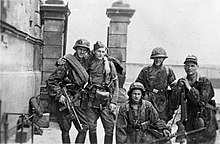On 6 June 1944 (known as D-Day), after three years of Soviet pressure, the Western Allies invaded northern France. After reassigning several Allied divisions from Italy, they also attacked southern France. These landings were successful, and led to the defeat of the German Army units in France. Paris was liberated by the local resistance assisted by the Free French Forces on 25 August and the Western Allies continued to push back German forces in Western Europe during the latter part of the year. An attempt to advance into northern Germany spear-headed by a major airborne operation in the Netherlands ended with a failure. The Allies also continued their advance in Italy until they ran into the last major German defensive line.
On 22 June, the Soviets launched a strategic offensive in Belarus (known as "Operation Bagration") that resulted in the almost complete destruction of the German Army Group Centre. Soon after that, another Soviet strategic offensive forced German troops from Western Ukraine and Eastern Poland. The successful advance of Soviet troops prompted resistance forces in Poland to initiate several uprisings, though the largest of these, in Warsaw, as well as a Slovak Uprising in the south, were not assisted by the Soviets and were put down by German forces. The Red Army's strategic offensive in eastern Romania cut off and destroyed the considerable German troops there and triggered a successful coup d'état in Romania and in Bulgaria, followed by those countries' shift to the Allied side.
In September 1944, Soviet Red Army troops advanced into Yugoslavia and forced the rapid withdrawal of the German Army Groups E and F in Greece, Albania and Yugoslavia to rescue them from being cut off. By this point, the Communist-led Partisans under Marshal Josip Broz Tito, who had led an increasingly successful guerrilla campaign against the occupation since 1941, controlled much of the territory of Yugoslavia and were engaged in delaying efforts against the German forces further south. In northern Serbia, the Red Army, with limited support from Bulgarian forces, assisted the Partisans in a joint liberation of the capital city of Belgrade on 20 October. A few days later, the Soviets launched a massive assault against German-occupied Hungary that lasted until the fall of Budapest in February 1945. In contrast with impressive Soviet victories in the Balkans, the bitter Finnish resistance to the Soviet offensive in the Karelian Isthmusdenied the Soviets occupation of Finland and led to the signing of Soviet-Finnish armistice on relatively mild conditions, with a subsequent shift to the Allied sideby Finland.
By the start of July, Commonwealth forces in Southeast Asia had repelled the Japanese sieges in Assam, pushing the Japanese back to the Chindwin River while the Chinese captured Myitkyina. In China, the Japanese were having greater successes, having finally captured Changsha in mid-June and the city of Hengyang by early August. Soon after, they further invaded the province of Guangxi, winning major engagements against Chinese forces at Guilin and Liuzhou by the end of November and successfully linking up their forces in China and Indochina by the middle of December.
In the Pacific, American forces continued to press back the Japanese perimeter. In mid-June 1944 they began their offensive against the Mariana and Palau islands, scoring a decisive victory against Japanese forces in the Philippine Sea within a few days. These defeats led to the resignation of Japanese Prime Minister Tōjō and provided the United States with air bases to launch intensive heavy bomber attacks on the Japanese home islands. In late October, American forces invaded the Filipino island of Leyte; soon after, Allied naval forces scored another large victory during the Battle of Leyte Gulf, one of the largest naval battles in history.


No comments:
Post a Comment